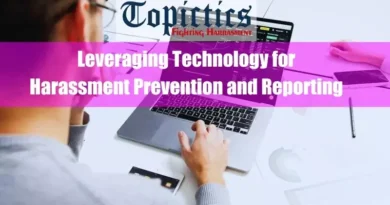Physical vs. Visual vs. Online Harassment
Harassment takes many forms, each impacting individuals in distinct ways. Physical harassment involves unwanted physical contact or intimidation, visual harassment includes exposure to offensive images or gestures, and online harassment occurs through digital platforms.
Understanding the differences among these forms is crucial for recognizing and addressing them effectively.
Takeaways
| Key Points |
|---|
| Physical harassment involves direct, unwanted physical contact or intimidation, such as touching, assault, or blocking someone’s path, often leading to psychological and physical harm. |
| Visual harassment, by contrast, uses offensive visual content like obscene gestures, inappropriate exposure, or explicit materials to create hostile environments, which can disrupt workplaces and personal well-being. |
| Online harassment leverages digital platforms to harass, intimidate, or threaten individuals through cyberstalking, doxxing, or spreading harmful content like deep fakes, amplified by the anonymity and reach of the internet. |
| All three forms of harassment share similarities in their detrimental impacts, such as anxiety, depression, and decreased sense of safety, yet differ in medium and context, making prevention and legal accountability complex. |
| Acknowledging their overlap, such as when physical harassment extends into online or visual abuse, highlights the need for comprehensive, evolving strategies to address these pervasive behaviors. |
Physical Harassment

Definition and Explanation
Physical harassment refers to any form of unwanted physical contact or physical intimidation. It often involves actions that invade personal space or violate an individual’s bodily autonomy. Physical harassment can occur in various environments, including workplaces, schools, public spaces, and even within personal relationships.
Common Forms of Physical Harassment
Physical harassment manifests in several ways, often making it difficult for victims to feel safe or comfortable in their environment. Some common forms include:
- Unwanted Touching: This can range from inappropriate touching to more aggressive forms such as grabbing or groping.
- Physical Intimidation: This involves using one’s physical presence to threaten or coerce someone. It could include blocking someone’s path, standing too close, or using physical gestures that imply a threat.
- Assault: In severe cases, physical harassment escalates to assault, which may include hitting, slapping, or any other form of violence.
Psychological and Physical Effects
The impact of physical harassment extends beyond the immediate discomfort or pain caused by the act itself. Victims often experience long-term psychological effects such as anxiety, depression, and post-traumatic stress disorder (PTSD). Physically, victims may suffer from injuries, sleep disturbances, and other stress-related health issues.
Legal Protections and Remedies
Legal protections against physical harassment vary by jurisdiction, but many countries have laws to protect individuals from such behavior. Victims can seek remedies through civil or criminal legal actions, which may result in penalties for the perpetrator, including fines, restraining orders, or imprisonment.
Workplace policies often provide additional protections, including formal reporting mechanisms and disciplinary actions against offenders.
Visual Harassment

Definition and Explanation
Visual harassment involves exposing an individual to offensive or inappropriate visual content. It can occur in public spaces, workplaces, or private settings. Visual harassment often targets a person’s gender, race, or other personal characteristics, contributing to a hostile environment.
Examples of Visual Harassment
Visual harassment can take various forms, including:
- Offensive Images or Posters: Displaying images or posters that contain explicit content, hate symbols, or other offensive material can create an unwelcoming environment.
- Obscene Gestures: Gestures such as lewd hand signals or facial expressions can be deeply unsettling and are a form of visual harassment.
- Inappropriate Exposure: Exposing oneself or showing explicit material to others without their consent is another severe form of visual harassment.
Impact on Victims
The impact of visual harassment is significant, often leading to feelings of violation, discomfort, and distress. Victims may experience anxiety, decreased productivity, and a sense of alienation. In workplace settings, visual harassment can disrupt the work environment, leading to increased absenteeism and turnover.
Workplace and Public Space Considerations
Employers and public authorities are increasingly recognizing the need to address visual harassment proactively. This involves creating policies that prohibit the display of offensive material, training employees on recognizing and reporting harassment, and ensuring that public spaces are monitored to prevent such behavior.
Legal Framework
Legal recourse for visual harassment is available in many jurisdictions, though navigating it can be complex. Victims may file complaints with human rights commissions or seek legal action through civil courts. Laws related to hate speech, obscenity, and discrimination often intersect with cases of visual harassment, providing a framework for holding perpetrators accountable.
Online Harassment
Definition and Explanation
Online harassment, or cyber harassment, uses digital platforms to harass, threaten, or intimidate individuals. This form of harassment has grown with the rise of social media, online forums, and other digital communication tools. Online harassment can be particularly insidious because it allows perpetrators to maintain anonymity, making it easier for them to engage in persistent and harmful behavior.

Forms of Online Harassment
Online harassment comes in many forms, including:
- Cyberstalking: Repeatedly sending threatening or unwelcome messages, obsessively following someone’s online activities, or using digital tools to track their real-world location.
- Doxxing: Publishing someone’s private information, such as a home address or phone number, with malicious intent.
- Deep Fakes: Creating and distributing manipulated videos or images falsely portraying someone in a compromising situation.
Psychological and Emotional Impact
The psychological toll of online harassment can be severe, leading to anxiety, depression, and feelings of helplessness. The public and often permanent nature of online harassment can exacerbate these effects, making it difficult for victims to move past the experience.
The pervasive nature of digital communication means that victims may feel constantly vulnerable, with no safe space to escape the harassment.
The Role of Anonymity and Social Media
Anonymity plays a significant role in online harassment, as it encourages perpetrators to engage in behavior they might avoid in face-to-face interactions. Social media platforms, while providing tools for connection and expression, also create opportunities for harassment. Online content’s viral nature means harmful material can spread rapidly, amplifying the damage.
Legal Precedents
Legal systems worldwide are increasingly recognizing the need to address online harassment. Many countries have enacted laws that criminalize specific forms of online harassment, such as cyberstalking and revenge porn.
However, the global nature of the internet presents challenges in enforcement, as laws vary widely between jurisdictions.
Comparative Analysis of Physical, Visual, and Online Harassment
Similarities and Differences
While physical, visual, and online harassment have distinct characteristics, they share common elements. All three forms involve unwanted behavior that infringes on an individual’s rights and dignity. However, the mediums and methods differ. Physical harassment is direct and tangible, visual harassment often involves passive yet impactful exposure, and online harassment uses digital means to inflict harm.
The Interconnectedness of the Three Forms
These forms of harassment are interconnected, often overlapping in ways that compound their effects on victims. For example, a person may experience physical harassment at work, visual harassment in the form of offensive materials, and online harassment through cyberstalking or derogatory social media posts.
Each form of harassment can reinforce the other, creating an environment of pervasive intimidation and harm.
Challenges in Addressing and Preventing Each Type
Addressing harassment in any form is challenging, particularly due to the varying contexts in which it occurs. Physical harassment is often easier to identify and address through direct intervention. Still, visual and online harassment can be more subtle and difficult to prove.
Legal frameworks are evolving, but inconsistencies across jurisdictions and the rapid development of new technologies create ongoing challenges in effectively preventing and addressing these behaviors.
Strategies for Prevention and Response

Preventing and responding to harassment effectively requires tailored strategies for each type, recognizing their unique challenges and dynamics. Below are the key strategies for preventing and responding to physical, visual, and online harassment:
1. Physical Harassment
- Comprehensive Workplace Policies: Organizations must develop and enforce clear policies that define physical harassment and establish a zero-tolerance stance. These policies should include procedures for reporting incidents and protections against retaliation for those who come forward.
- Employee Training Programs: Regular training sessions should be conducted to educate employees about what constitutes physical harassment, how to recognize it, and how to respond. This training should include role-playing scenarios to help employees understand the impact of their actions and the importance of respecting personal boundaries.
- Immediate Incident Reporting Mechanisms: Establishing anonymous and accessible reporting channels is crucial. These mechanisms should allow employees to report harassment incidents without fear of reprisal. Reports should be investigated promptly and thoroughly.
- Physical Security Measures: Physical security measures, such as surveillance cameras in common areas and well-lit premises, can deter potential harassers. Additionally, having security personnel available to respond to incidents can provide immediate support to victims.
- Support Services for Victims: Offering counseling services and support groups for victims of physical harassment can help them recover from the trauma. Organizations should also provide legal assistance for those seeking legal action against their harassers.
- Regular Audits and Reviews: Organizations should conduct regular audits of their harassment prevention policies and practices to ensure they are effective. This includes reviewing incident reports, assessing the effectiveness of training programs, and making necessary policy adjustments.
2. Visual Harassment
- Clear Definition of Inappropriate Material: Organizations should clearly define what constitutes offensive or inappropriate visual content within their policies. This includes specifying that explicit, derogatory, or discriminatory images and gestures are prohibited in the workplace.
- Monitoring and Control of Displayed Content: Employers should monitor the content displayed in shared spaces, such as posters, screensavers, and digital displays, to ensure that it adheres to workplace standards. This can be done through regular inspections and employee feedback mechanisms.
- Prompt Removal of Offensive Materials: There should be a clear process to remove any offensive visual content reported or discovered. This includes digital content displayed on company networks or physical materials in shared spaces.
- Education on the Impact of Visual Harassment: Regular workshops and training sessions should educate employees about the psychological and emotional impact of visual harassment. Understanding the harm caused by such actions can foster a more respectful workplace environment.
- Legal Compliance and Awareness: Employers must stay informed about legal requirements related to visual harassment and ensure that their policies comply with national and local laws. This includes being aware of anti-discrimination laws that apply to visual harassment.
- Support for Affected Individuals: It is essential to provide resources such as counseling and peer support for individuals affected by visual harassment. Employers should also offer guidance on documenting incidents for legal or HR reporting purposes.
3. Online Harassment
- Robust Online Reporting Systems: Digital platforms should implement comprehensive reporting systems that allow users to report online harassment quickly and easily. These systems should be accessible, with clear instructions on reporting and what constitutes harassment.
- Content Moderation and AI Tools: Technology companies must invest in advanced AI tools and human moderators to identify and remove harmful content, such as cyberbullying, doxxing, and deep fakes. These tools should be regularly updated to respond to new forms of harassment.
- Education on Digital Etiquette and Safety: Educational initiatives aimed at teaching digital etiquette and online safety can help prevent online harassment. This includes understanding the consequences of online behavior and respecting others’ privacy and dignity online.
- Anonymity and Identity Verification: Platforms could implement stricter identity verification processes to reduce the anonymity that often enables online harassment. This might include options for users to verify their identity or limitations on anonymous interactions.
- Legal Recourse and Cooperation with Law Enforcement: Victims of online harassment should have access to clear legal recourse, with laws specifically addressing digital harassment. Platforms should also cooperate with law enforcement agencies to identify and prosecute offenders.
- Support Networks and Counseling: Providing access to online counseling services and support networks can help victims of online harassment. These resources should be readily available and promoted on platforms where harassment is common.
These strategies provide a comprehensive approach to preventing and responding to physical, visual, and online harassment.
By implementing these real-world, actionable steps, organizations, platforms, and individuals can work together to create safer environments across all settings.
Conclusion
Harassment in its various forms—physical, visual, and online—poses significant challenges to individuals and society. Understanding the distinctions and interconnections between these types of harassment is critical for developing effective prevention and response strategies.
Legal protections and societal awareness are gradually evolving. Still, continued efforts are needed to ensure everyone can live and work without harassment.
FAQ
What is physical aggression?
Physical aggression in harassment contexts involves the use of bodily force or the threat thereof to intimidate or control another individual, often manifesting as hitting, pushing, or other overt acts of violence. This term is essential in harassment assessments as it quantifies direct physical harm and informs the implementation of protective policies.
What is physical intimidation?
Physical intimidation refers to non-contact behaviors—such as aggressive posturing, menacing gestures, or threatening body language—that create fear of impending physical harm. It is a crucial metric in harassment surveys, as it helps organizations identify and mitigate behaviors that destabilize personal safety without actual physical contact.
What is visual harassment?
Visual harassment involves the use of images, gestures, or visual cues that are offensive or demeaning, such as displaying obscene symbols or using suggestive body language to intimidate. This technical term is pivotal in assessments because it captures non-verbal forms of abuse that can have significant psychological effects on the targeted individuals.
What is visual intimidation?
Visual intimidation is the deliberate use of visual cues—like intense staring, aggressive gestures, or intimidating displays—to instill fear or assert dominance over someone without physical contact. It is monitored in harassment assessments to understand better how visual signals contribute to an atmosphere of hostility and distress.
What is nonverbal harassment?
Nonverbal harassment encompasses behaviors that communicate hostility or disrespect without the use of words, including inappropriate gestures, facial expressions, and other body language that can demean or isolate an individual. Recognizing these subtle forms of abuse is critical for comprehensive harassment evaluations, as they can erode workplace morale and personal dignity over time.
What is cyberbullying?
Cyberbullying involves the repeated use of digital platforms to send harmful, threatening, or humiliating messages, targeting individuals based on perceived vulnerabilities. This term is a key focus in online harassment assessments, as it helps in designing interventions that protect users from sustained digital abuse and social exclusion.
What is cyberstalking?
Cyberstalking refers to the persistent and unwanted surveillance or tracking of individuals through digital means, including monitoring online activities or sending repeated threatening communications. It is an important metric in harassment assessments, as it highlights invasive behaviors that breach personal privacy and can escalate into severe psychological distress.
What is doxxing?
Doxxing involves the unauthorized release of private personal information—such as home addresses or contact details—intended to intimidate or harm the targeted individual. This technical term is essential in online harassment metrics, as it pinpoints a dangerous practice that can lead to real-world repercussions, including identity theft and physical danger.
What is revenge porn?
Revenge porn is the non-consensual sharing of explicit images or videos, often used as a means of retaliation to cause emotional distress and public humiliation. Recognizing this behavior in harassment assessments is critical for ensuring that measures are in place to protect individual’s privacy and dignity in digital spaces.
What is trolling?
Trolling involves deliberately posting inflammatory, off-topic, or provocative content online to incite strong emotional reactions or disrupt community interactions. This term is closely monitored in online harassment assessments, as persistent trolling can erode safe communication spaces and contribute to a culture of hostility.
What is digital hate speech?
Digital hate speech encompasses online expressions that demean or incite violence against individuals or groups based on characteristics such as race, religion, gender, or sexuality. It is a significant focus in harassment assessments because tracking such behavior is vital for developing strategies that maintain respectful and inclusive online environments.
What is online impersonation?
Online impersonation refers to creating or using a digital identity that mimics another person, often intending to deceive others or damage the target’s reputation. This term is critical in harassment evaluations, as it exposes a form of digital abuse that can lead to misinformation, personal harm, and breaches of trust.
What is visual voyeurism?
Visual voyeurism in the context of harassment involves observing or recording individuals without their consent, typically in settings where privacy is expected, often for exploitative or invasive purposes. It is a key technical term in assessments, highlighting invasive practices that violate personal boundaries and compromise the victim’s right to privacy.
What is a physical boundary violation?
Physical boundary violation refers to actions that intrude upon an individual’s personal space without consent, including unwanted touching or encroachment that can be perceived as threatening. This metric is vital in harassment assessments because it directly addresses behaviors that compromise both physical safety and the fundamental right to personal autonomy.
What is online defamation?
Online defamation involves disseminating false or damaging information about an individual through digital channels, intending to tarnish their reputation or cause personal harm. This technical term is integral to harassment surveys, as it captures a form of cyber abuse that can have lasting impacts on an individual’s personal and professional life.









